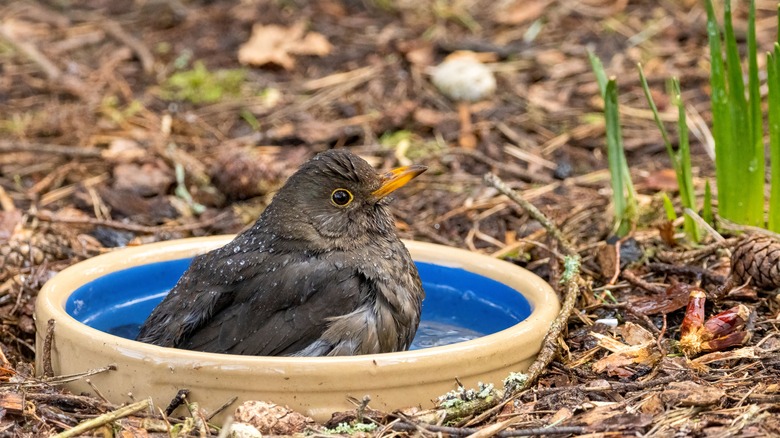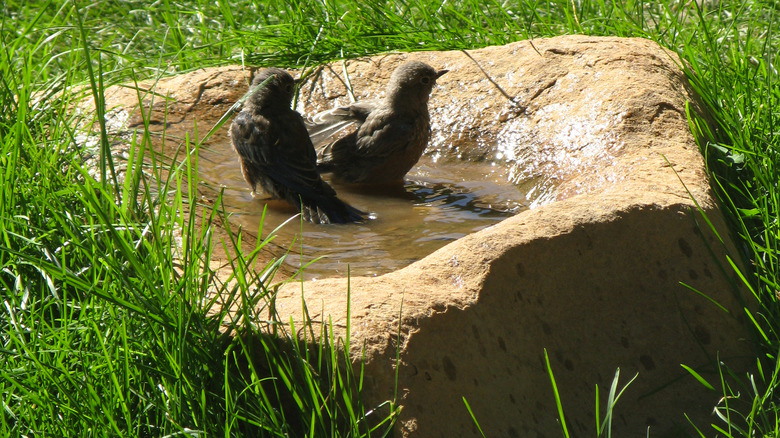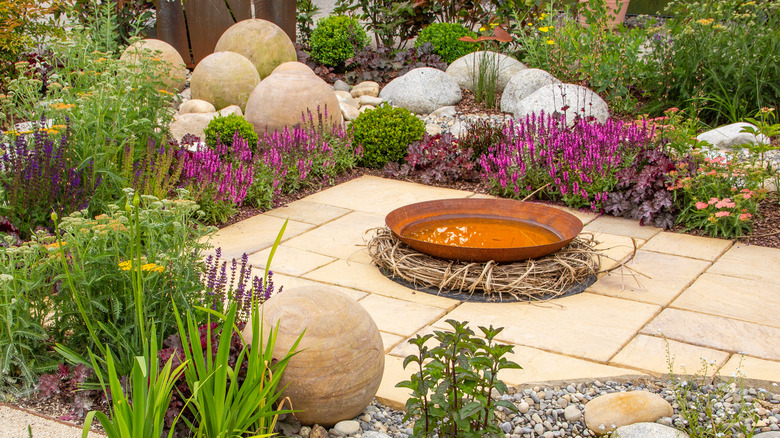What To Know About Ground Birdbaths (Good & Bad)
We may receive a commission on purchases made from links.
Your bird feeders are well-stocked with seed and nectar, and your garden is packed with avian-friendly native flowers, shrubs, and fruit trees. Wondering how to attract more songbirds to your yard — or any birds, for that matter? Install a birdbath! Birdbaths come in an enormous range of styles, from Renaissance-esque pedestal baths to fountains that you can hang from a branch. One mildly-contentious option is the in- or on-ground birdbath. Some experts praise them for their simplicity and close resemblance to natural water sources, while others scorn them for making birds more vulnerable to predation, among other downsides.
A birdbath of this type ranges from an old shallow baking pan placed atop or dug into a garden bed to elaborate hammock-style decorative bowls sitting on one side of your deck stairs. They're most commonly made of ceramic or stone but come in plastic, concrete, steel, and glass as well. Anything waterproof that will withstand all types of weather will do. Ground birdbaths attract terrestrial birds like grouse, quail, and domestic poultry and their wild cousins which include ducks, turkeys, and the like. They're also favored by avian ground-feeders like woodpeckers, sparrows, doves, thrashers, towhees, warblers, and cardinals.
The pros and cons of ground birdbaths
One positive aspect of ground birdbaths is that they can be remarkably uncomplicated and inexpensive. Almost any shallow, easy-clean dish can become a birdbath. Since they sit at ground level, you can put them pretty much anywhere in your garden, and they can't fall over or off a branch like a pedestal or hanging type. They more closely mimic natural water sources like streams and ponds, and birds may even prefer bathing in and drinking from ground baths over other types.
However, being located near the ground also has distinct drawbacks. A single snowfall and ground baths are rendered inaccessible unless fitted with a heater. Fall presents problems, as leaves dropped by trees can quickly fill a shallow type, dirtying the water. Birds drinking or bathing at ground level are more vulnerable to attacks from predators like cats and hawks than those doing the same at a flight-ready height in pedestal or hanging baths. If you don't carefully consider where you install your ground bath, you or visitors to your garden might trip over it.
When choosing your ground birdbath, go for one made from glazed or vitrified ceramic. They're generally more freeze-proof than concrete or metal alternatives. For example, you could get a Topadorn Ceramic Bowl Ground Birdbath with a center flower for about $33 on Amazon, or Duncraft has a Ceramic Frog Solar Fountain for around $140. Alternatively, a sizeable terracotta planter saucer or plastic trash can lid could also work.
Installing your ground birdbath
The bath should have a rough surface that's easy for birds' feet to grip and sides that gently slope to an eventual depth of 2 to 3 inches. Place a handful of stones into the center for birds to stand on and insects and small mammals to use as an escape. Aim for a dish that's around 12 inches in diameter or larger. You can either choose one with or without feet, but keep in mind that a stand can help protect the grass underneath from becoming damaged. Other special features you could add include a heater or a fountain in your birdbath. Technically, for your dish to qualify as a "ground bath," it needs to sit within 6 inches of the ground.
Some experts say to place your ground birdbath in a spot with clear visibility with tall shrubs or trees nearby. Conversely, others recommend putting it somewhere with a lot of ground cover. Experiment to find out which works better in your garden. Choose a shady spot with no slope to keep the water cool and level for your ground bath, and don't place it under your bird feeder, as falling seeds and feces could dirty the water. Finally, clean it regularly to protect both your feathered friends and your family, as backyard birds have been linked to human salmonella outbreaks.


